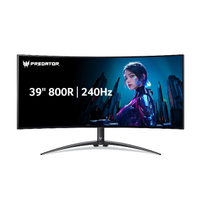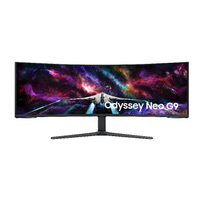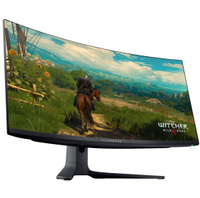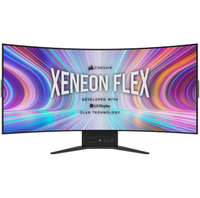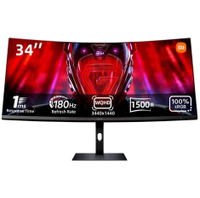Best curved monitors for gaming in 2025: These are the bendy displays I'd plant myself in front of
Immerse yourself to the max with these vision-enclosing panels.

The best curved gaming monitors are best suited to immersive gaming experiences. The wider the screen, and the curvier the panel, the more of your vision is engrossed in your game.
The best curved gaming monitor right now is the Alienware 32 AW3225QF, which offers seriously fantastic high-end visuals thanks to its Samsung 3rd Gen QD-OLED panel. It packs in tons of pixels into 32 inches of screen space, and of course, maintains the snappiness and vibrancy of the best OLED gaming monitors on the market today.
You don't need to spend thousands on a decent curved monitor either. If you're looking to spend less cash, you might consider the Pixio PXC277 Advanced, which is our pick for the best budget 1440p curved monitor right now. Its 165 Hz refresh rate and 1 ms rated response times are very respectable for gaming today, and it delivers superb performance for such a low price point. And if that's still a little much for you, you might want to check out the AOC Gaming C27G4ZXE, our pick for the best budget 1080p curved monitor.

Dave's been testing PC hardware for the best part of 20 years and has seen every kind of screen imaginable. As such he knows what makes differentiates good curves from bad curves, as well as what makes for a great gaming monitor in general. Whether we're talking LCD, OLED, mini-LED, or plain ol' CRT, he's had his eyes on them all and has personally checked out all of theaw best curved gaming monitors.
May 22, 2025: To add the Gigabyte M034WQC2 OLED gaming monitor to our 'also tested' section. It's a great screen but a bit plain in the wider market, and pretty pricey at that. We have checked over the rest of our guide for formatting, too.
April 22, 2025: Added the Samsung Odyssey OLED G9 G93SC as our pick for the best 32:9 curved monitor because, compared to the G9 Ne,o it has a stunning OLED panel and a more manageable resolution with 1440 pixels on the vertical axis. We replaced this Neo G9 with the ROG Swift OLED PG34WCDM as our best ultrawide pick, primarily because of its gorgeous WOLED panel. We also listed the 1080p AOC Gaming C27G4ZXE because it's a great option for those who don't want to push up to the 1440p Pixio. A few more monitors have also been added to the Also Tested section.
February 19, 2025: Updated our Also Tested section and tidied up the review copy and navigation. All of our recommendations remain the same, as these are still the very best curved gaming monitors money can buy.
The Quick List

The best overall
This 32-inch Alienware OLED display packs some seriously high-end specs and impressive pixel density. It's a 16:9 stunner, but if you're looking for ultrawides, we've got them here too.

The best budget 1440p
The PXC277 is far from a bargain basement item. At this price point, I was willing to make a few excuses, but that's not actually necessary here. This monitor delivers: The Pixio PXC277 Advanced does almost everything pretty darned well without breaking the bank.

The best budget 1080p
This AOC monitor might not have the best pixel density, but you're getting a curved 27-inch monitor with a whopping 280 Hz refresh rate for a very affordable price tag.

The best ultrawide
With this Asus display's superb image quality, excellent text handling, and a super-fast 240 Hz refresh rate, there's very little not to like about this stunning OLED display. Oh, apart from its price, but did you expect any less of an ultrawide OLED?
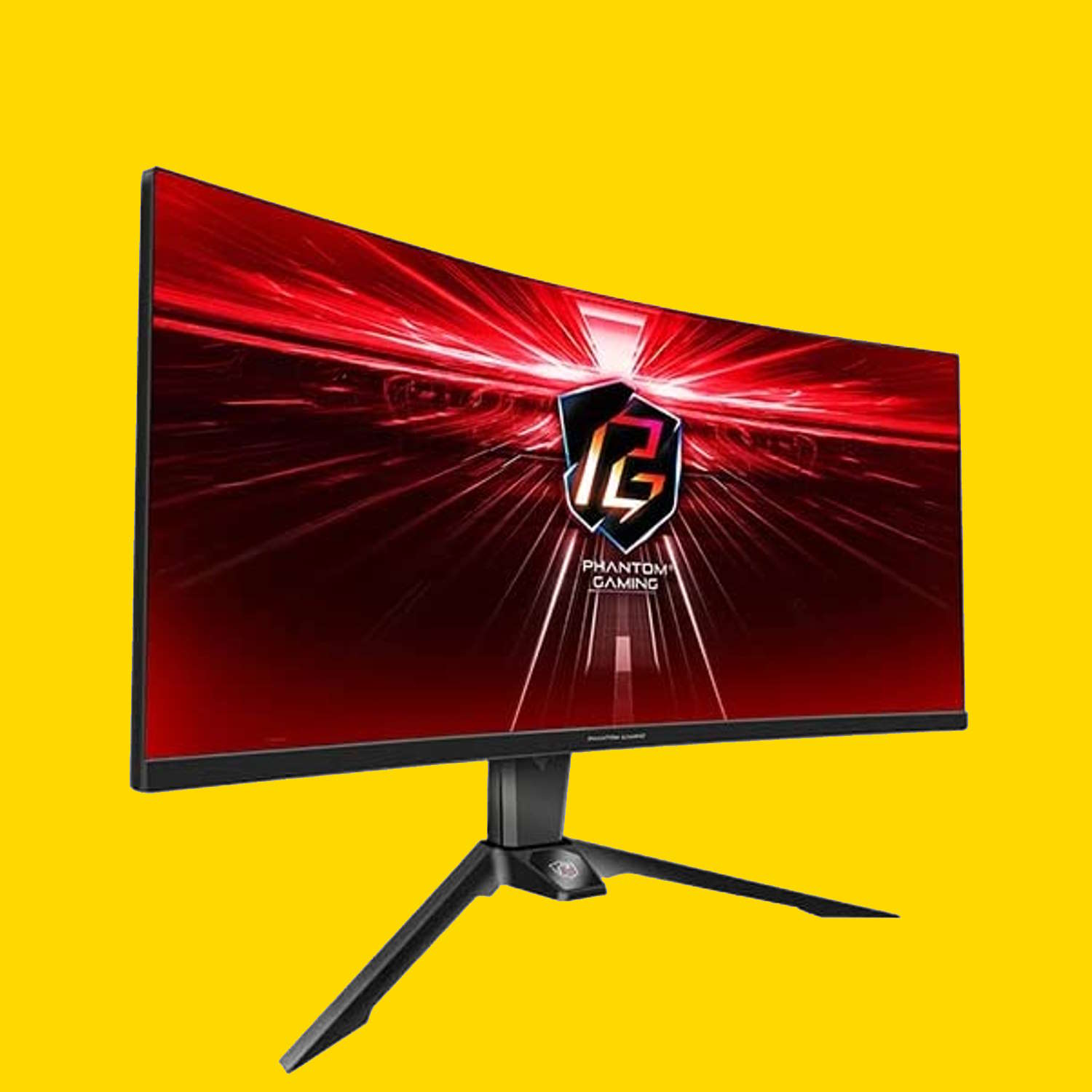
The best budget ultrawide
This monitor packs some great contrast thanks to its VA panel, with tons of backlight punch (provided you run the screen in HDR mode), decent pixel response times, and a respectable refresh rate.
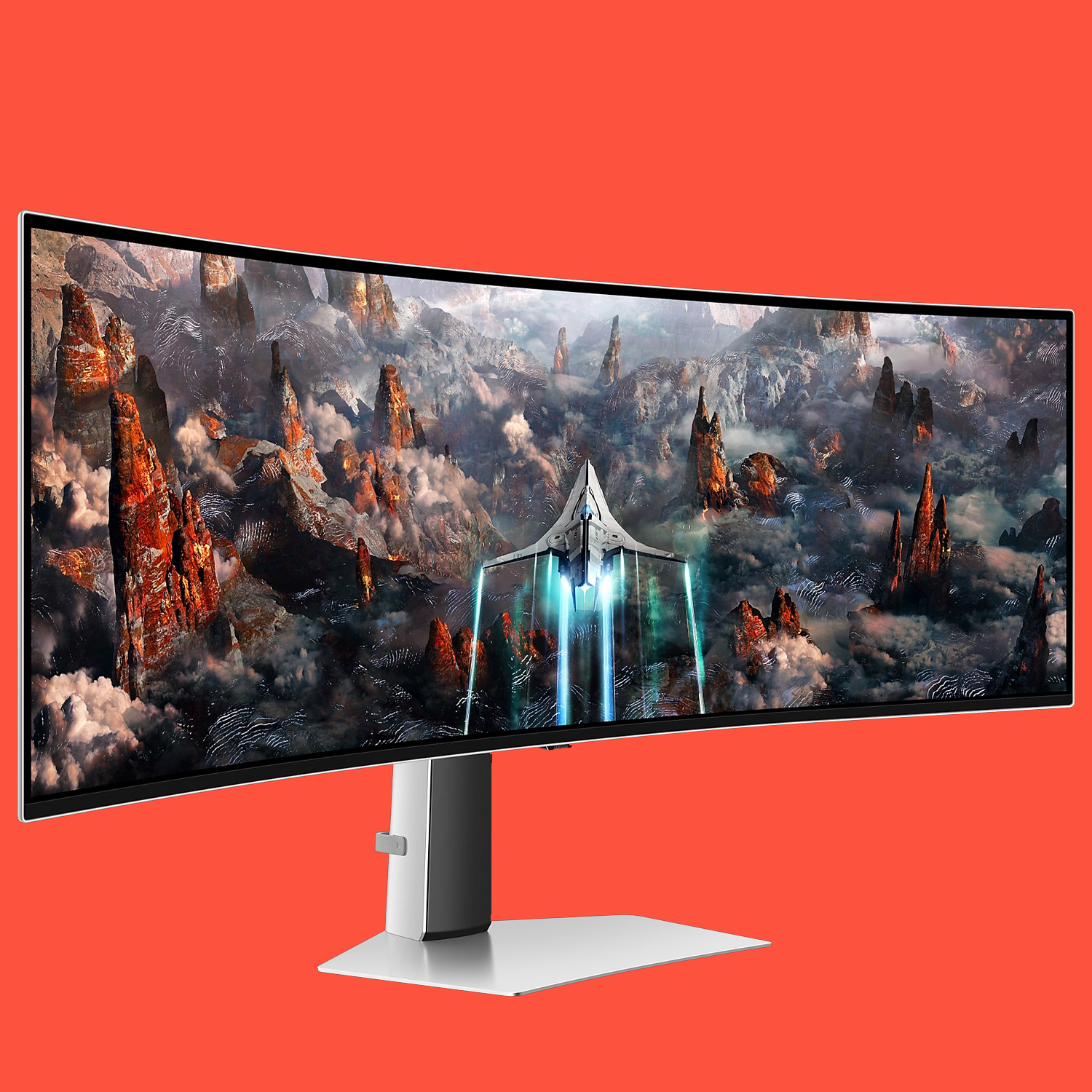
The best 32:9
Nothing beats Samsung's OLED G9 display for sheer scale and gaming luxury. The 32:9 aspect ratio doesn't gel with every game, but where it does, the G9 offers unrivalled immersion.
The best overall curved gaming monitor

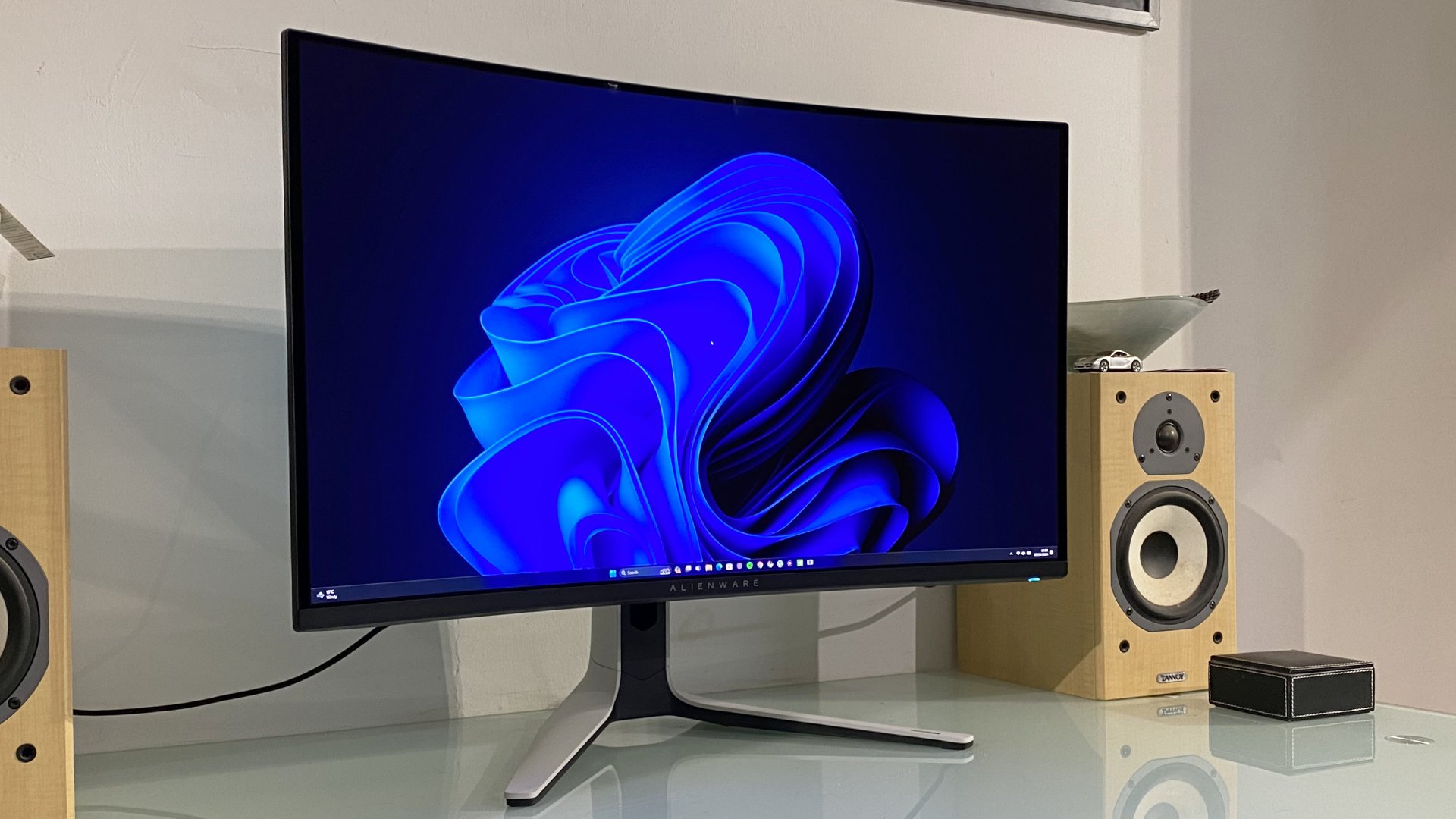
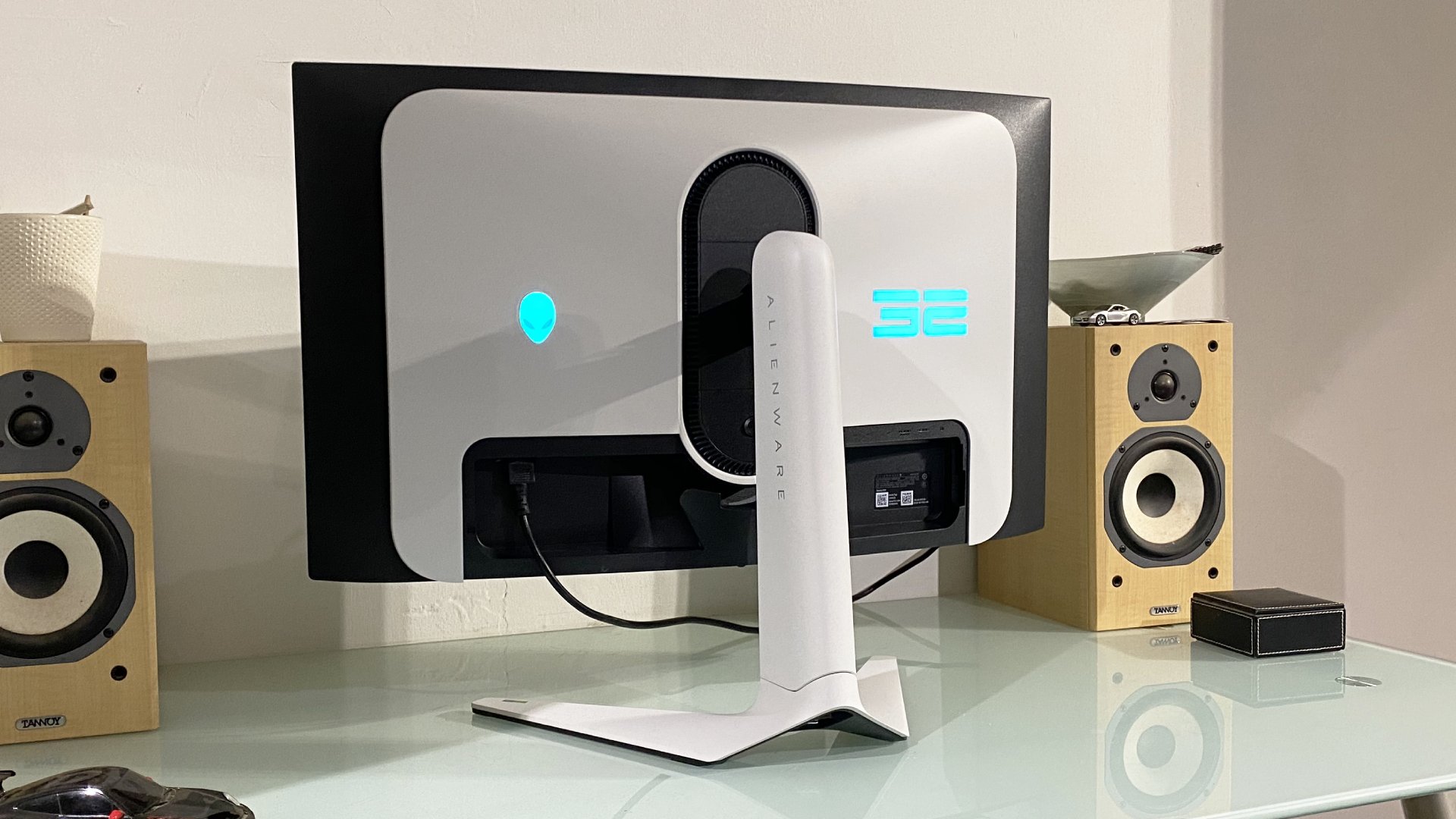
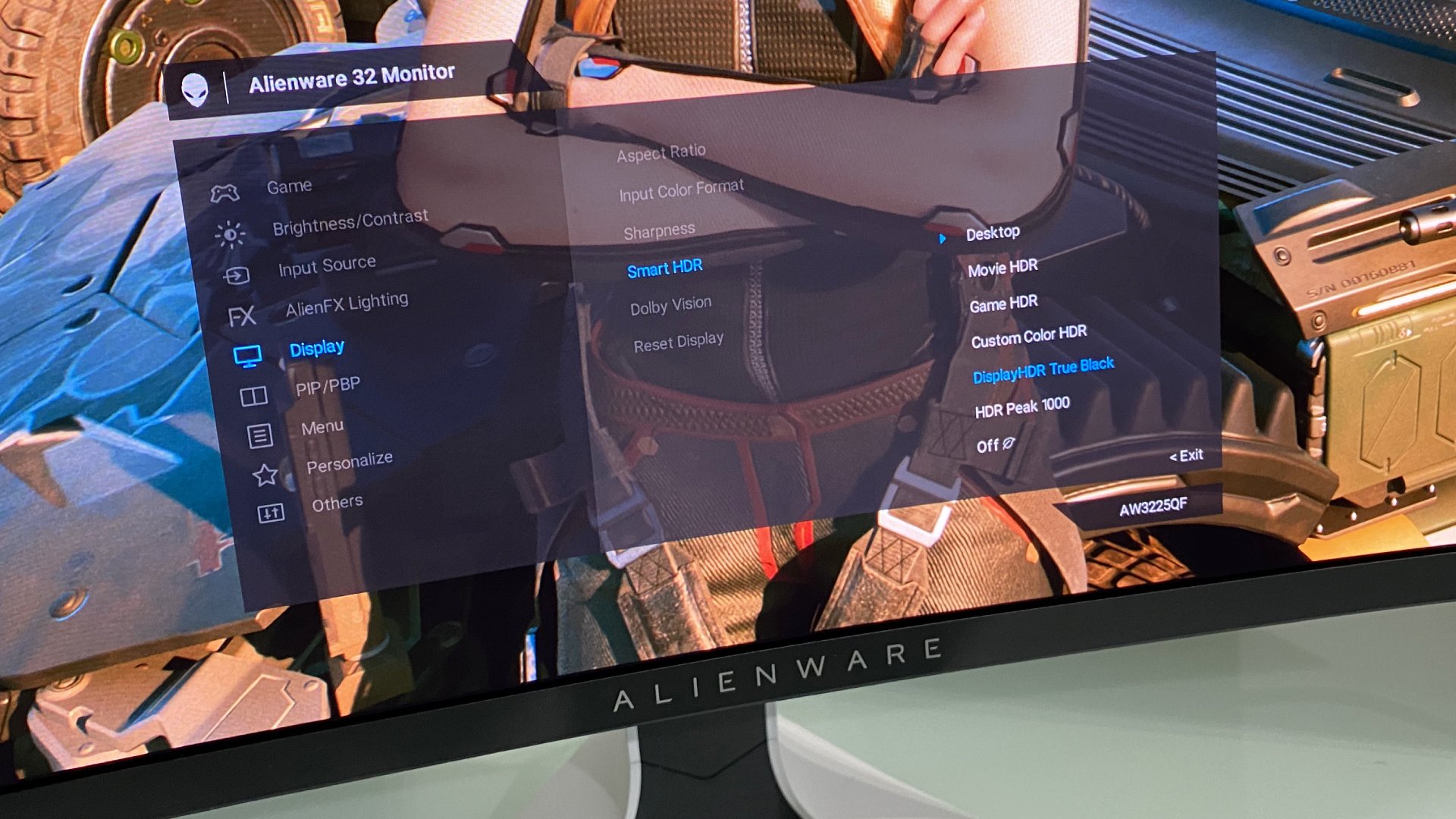
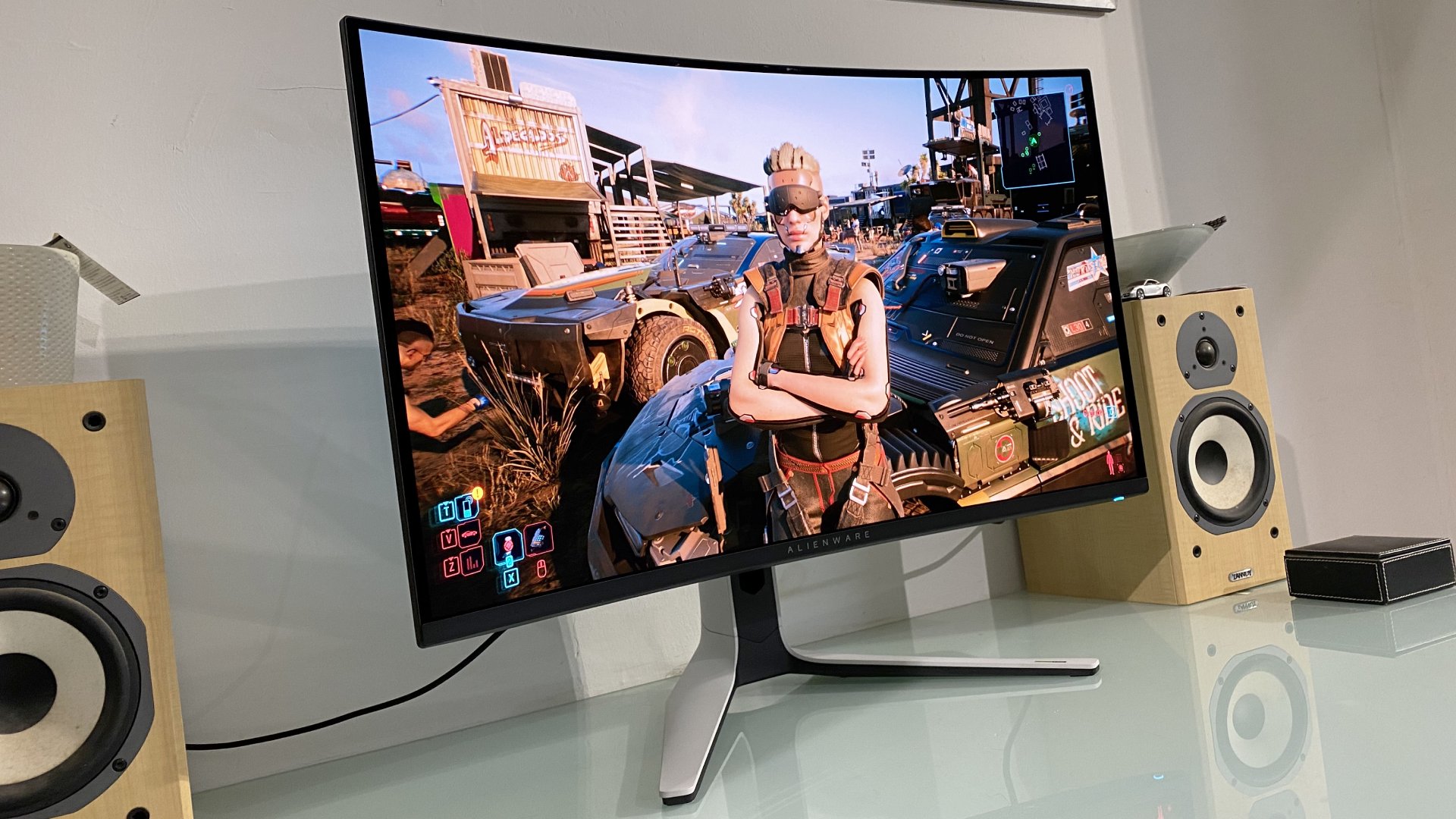
Specifications
Reasons to buy
Reasons to avoid
✅ You want 4K crispness and OLED lighting: Perfect per-pixel lighting, snappy OLED speed, plus 4K pixel density is an incredible combo.
❌ You want a simple life: What with all the HDR settings and the OLED panel management, life isn't simple in 4K OLED land.
The Alienware 32 AW3225QF is the best curved gaming monitor because, simply put, it ticks all the high-end display boxes. You're not getting any somewhat niche features like an ultrawide aspect ratio or ultra-curved panel. No, you're just getting a gorgeous 16:9 display with some stellar specs to boot.
The AW3225QF runs a Samsung 3rd Gen QD-OLED panel, which really brings high-end OLED gaming in for a home run. To be specific, the Alienware 32 AW3225QF has somehow crammed a 4K resolution's worth of pixels into a 32-inch OLED screen for some seriously stunning pixel density.
This pixel density, apart from aiding wonderful in-game visuals, also helps mitigate text fringing, which is a common complaint about OLED panels. You have to get very close to see any fringing here, and even then it's slight.
You're getting solid specs all around, too. We're talking 0.03 ms response times, 1,000 nits peak HDR, and 250 nits full-screen brightness, and 99% DCI-P3 coverage. Oh, and a 240 Hz refresh rate. You can't ask for much more for gaming—you're getting a fast and responsive experience in addition to gloriously vibrant and crisp visuals.
The only downsides to this monitor, apart from its expensive price tag, are the same ones that face almost any OLED. As our Jeremy said in his review, this thing is "an elusive angstrom or three away from perfection", these angstroms borne from the added difficulty required to keep on top of burn-in mitigation settings and measures, plus the fact that "there's not a single optimal setting for HDR".
Still, these are little niggles in the face of an extraordinarily capable monitor that delivers an incredibly fast and vibrant display experience. It would be a fantastic panel, whether curvy or not, but throw in its subtle 1700R curvature, and you have the best curved gaming monitor on the market.
Read our full Alienware 32 AW3225QF review.
The best budget 1440p curved gaming monitor
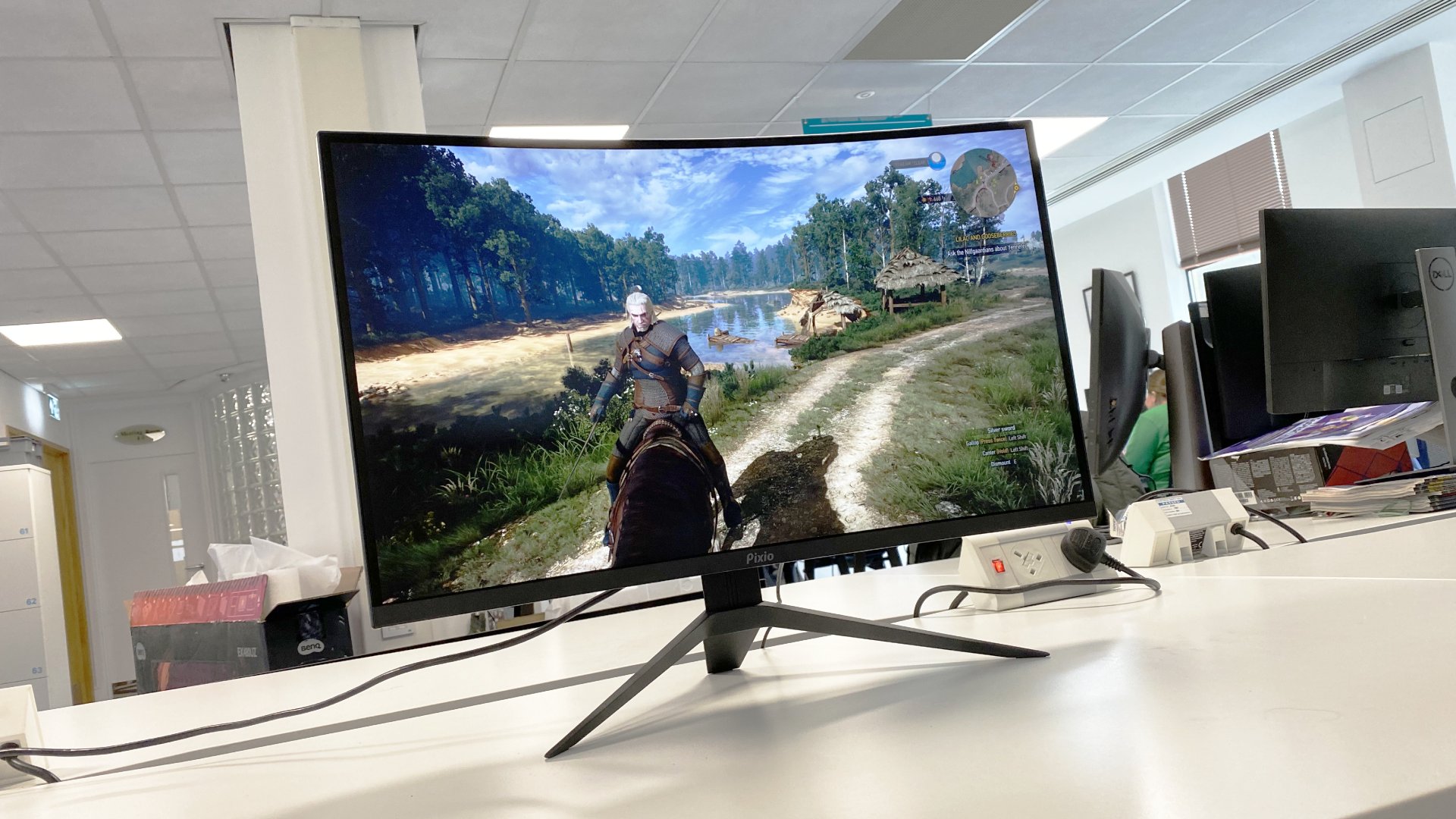
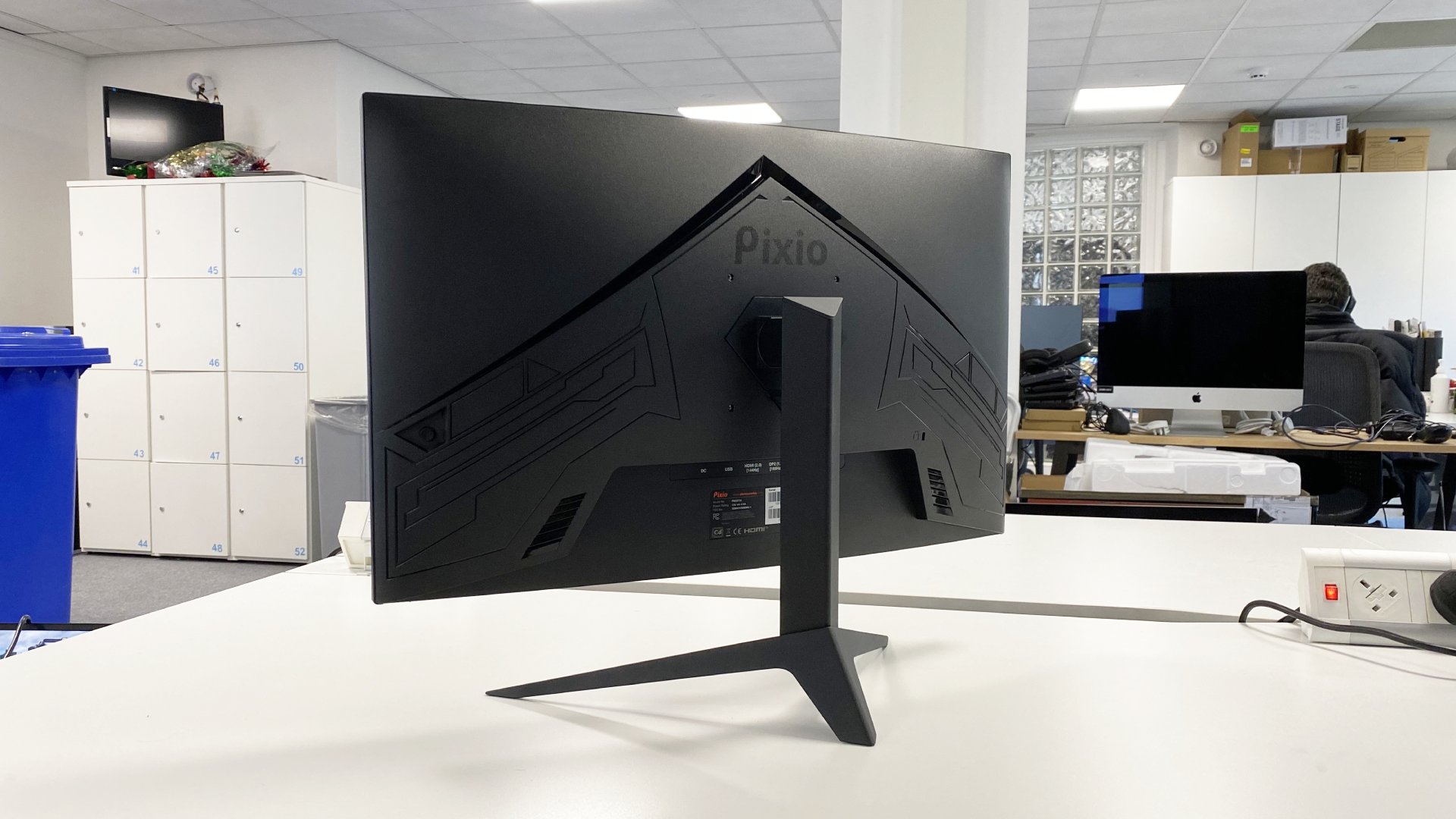
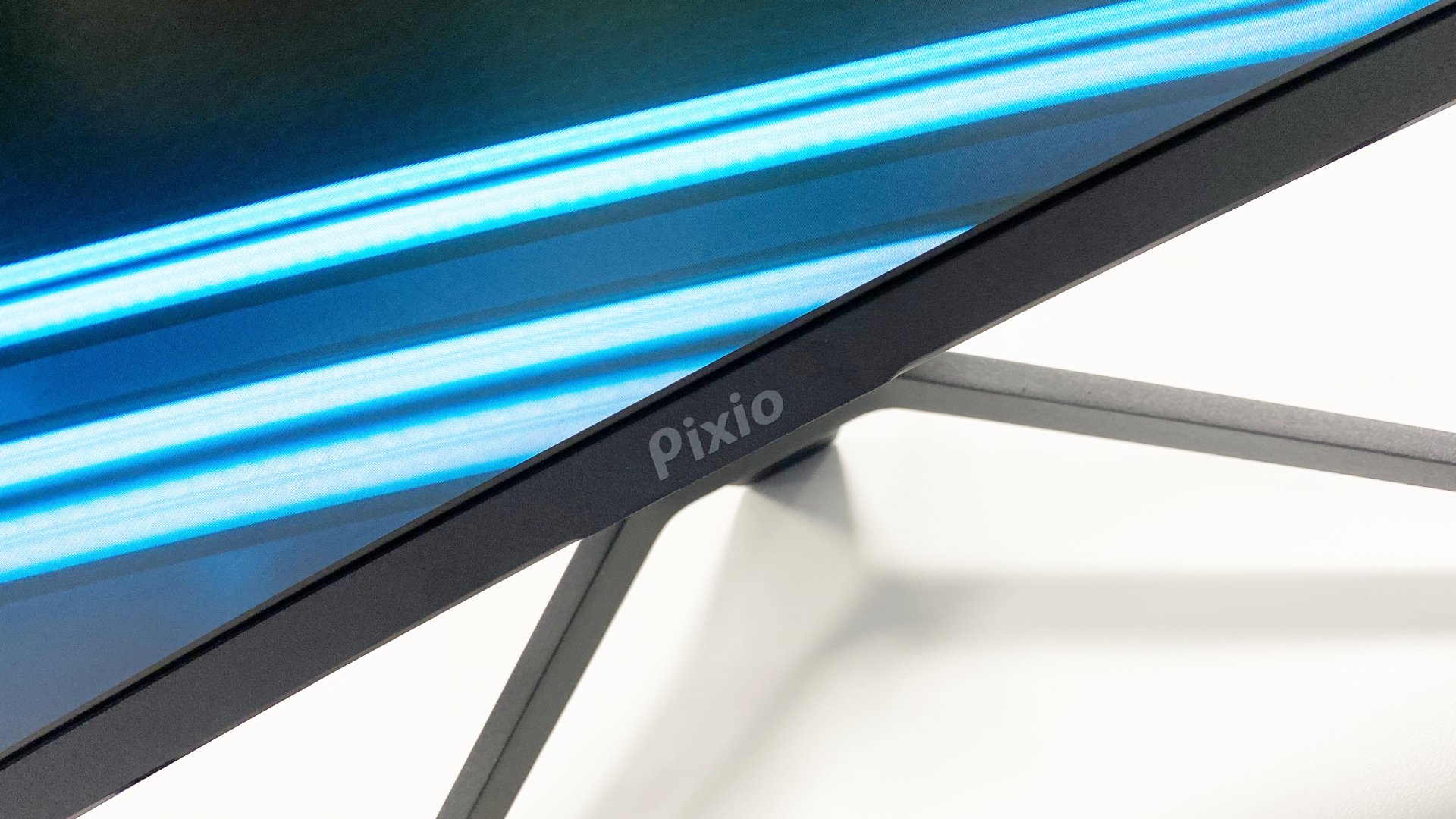

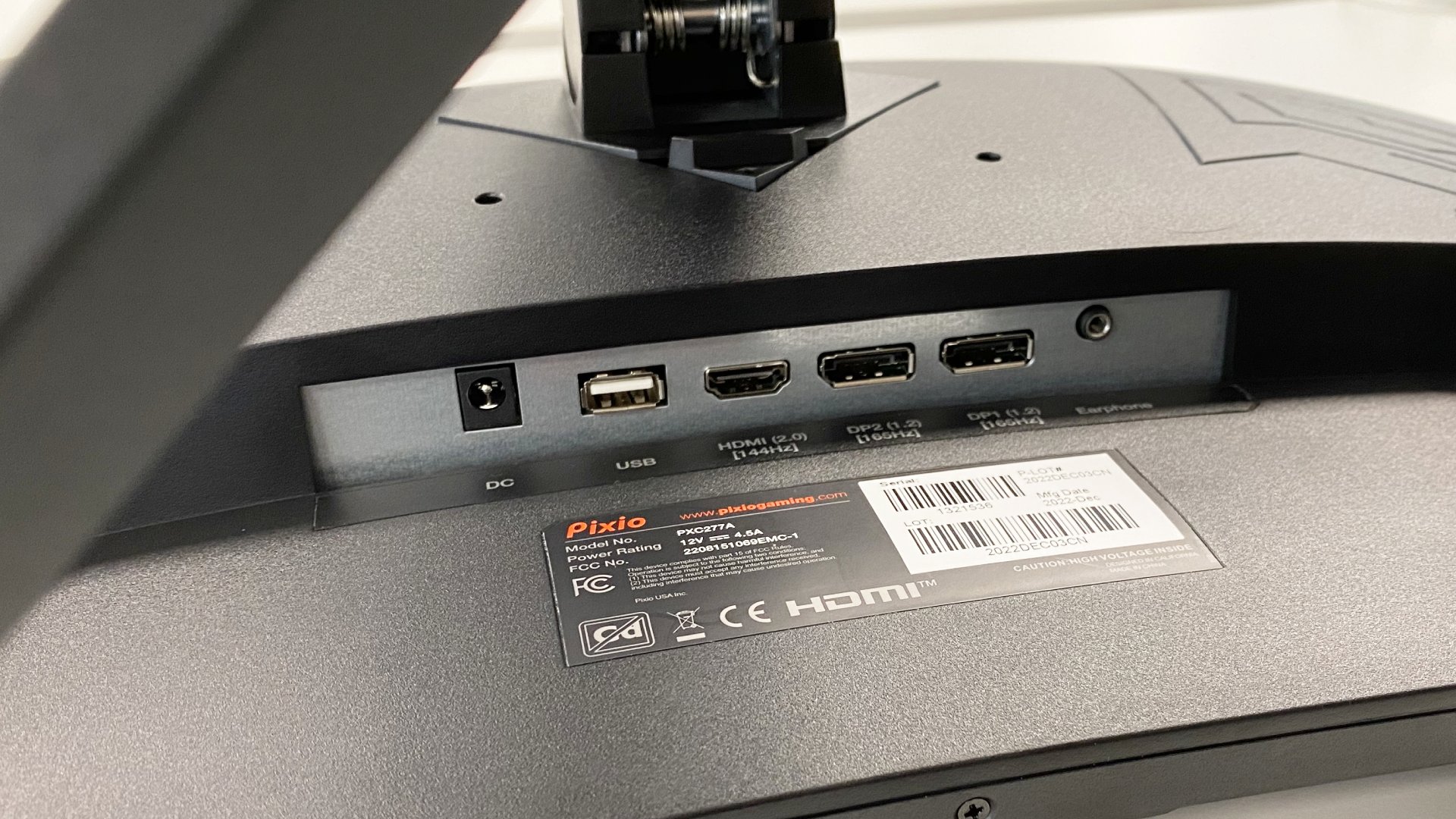
Specifications
Reasons to buy
Reasons to avoid
✅ You want a great value curved display: You're getting a spec list here that would have set you back double this price just a few years ago.
❌ You want to use HDR in games: The peak brightness and weak backlighting don't help the HDR experience, so you'll be sticking to SDR at all times.
The Pixio PXC277 Advanced is the best budget 1440p curved gaming monitor because it's a solid all-rounder for the price. Nothing unnecessary, just a monitor that nails all the fundamentals at a very reasonable price.
With the PXC277 Advanced, you're getting a 27-inch, 165 Hz monitor with a 1 ms response time. Importantly, at 320 nits, this monitor is brighter than some more expensive VA panels, and of course, still delivers on the lovely deep blacks that VA panels are famed for.
Its 1 ms rated response time isn't quite as snappy as this in practice, but if you set overdrive to low, you can get a fast experience with little ghosting or overshoot. You're always going to get slightly higher latency with a VA panel, but the PXC277 is far from the worst in this regard.
Put all this together, and you have a monitor that will suit most gamers. It's fast, and, most importantly, you're getting stellar visuals straight out of the box. While it has a lacklustre HDR experience, the monitor is calibrated well, and things look pretty vibrant for such a cheap monitor, with lovely deep blacks and stellar contrast.
It is worth noting that, at 27 inches, you won't notice the curve here as much as you would in bigger monitors, but this makes this budget choice a good entry point for prospective buyers.
The icing on the cake is that it doesn't look at all budget on the desk, thanks to its premium-looking bezels and tri-leg metal stand. For the price, you can't really go wrong with this one.
Read our full Pixio PXC277 Advanced review.
The best budget 1080p curved gaming monitor

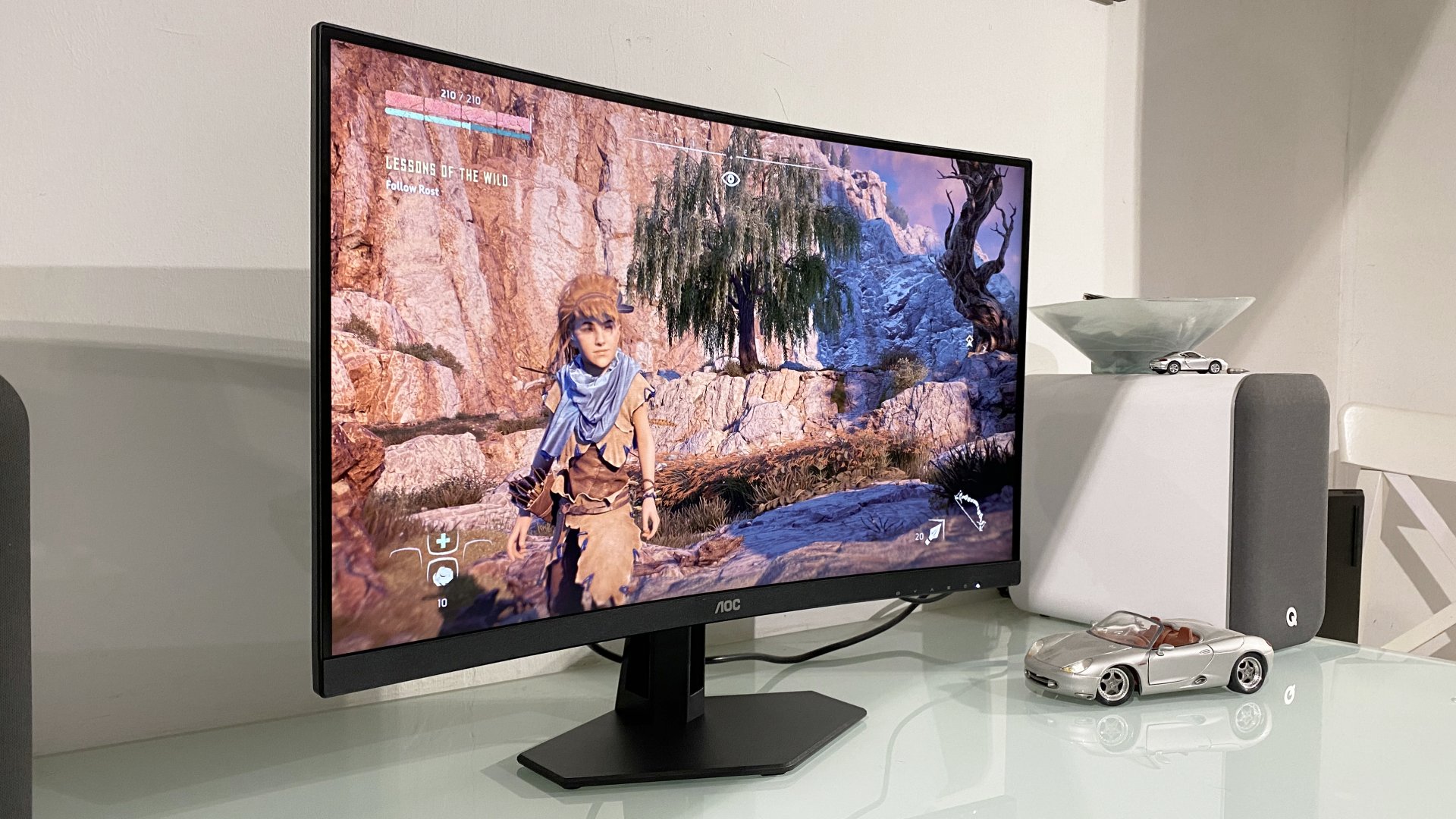



Specifications
Reasons to buy
Reasons to avoid
✅ You want a high refresh rate: A 280 Hz refresh rate is fantastic for the price of this monitor and helps provide a snappy and smooth gaming experience.
❌ You want great pixel response: Unfortunately, this monitor is limited by the VA panel it uses, which suffers from poor pixel response. Max overdrive can fix this, but not without causing overshoot and reverse ghosting.
The best budget 1080p curved gaming monitor is the AOC Gaming C27G4ZXE. It might not have much of a curve at just 1500R on a 27-inch monitor, but a curve it definitely has, and it's about as cheap as you'll get one on a decent panel.
Admittedly, this curve is so gentle that you might prefer to opt for a flat panel and have a little more wiggle-room with the rest of the monitor's specs, but if you're looking for that soft curve, then the circa $150 C27G4ZXE is fantastic for the price. Apart from its curvature, this monitor's all about refresh rate, as it pushes up to a whopping 280 Hz, which makes for some very snappy and smooth gameplay.
There is, of course, some give here to achieve such a high refresh rate on a curved monitor for such a low price, and that's its resolution. At 1080p, this 27-inch monitor has a pixel density of just 82 DPI, which is lower than you'll get in most standard monitors these days—27 inches along the diagonal, after all, is standard for a 1440p monitor.
So, you're sacrificing some pixels for the price and the refresh rate, but if you're looking towards 280 fps gameplay for that refresh rate, then, unless you have a beast of a PC, you're probably looking at running things at 1080p anyway. Which means this monitor gets things just right for those looking for that high refresh rate at a low cost.
The good news is that this AOC monitor's low pixel density does little to dampen the lovely visuals it's capable of producing. The VA panel is plenty punchy, as VAs often are, even though it's only rated up to 300 nits of peak brightness. Contrast is fantastic, and everything is well-calibrated at default settings—though things look a little dull in HDR mode, making this primarily an SDR monitor.
As tends to be the case with cheap monitors with VA panels, this one suffers from less than ideal pixel response, with some smearing and blurring visible except in a max overdrive mode that causes some inverse ghosting and overshoot. This poor pixel response, plus its low resolution, are the two main compromises for the price, here.
But those compromises are most definitely worth it if you're looking to save money on a curved monitor that looks great and can reach a very high refresh rate. If you can stretch your budget, a 1440p panel or an IPS panel might be a better choice, but it's hard to find fault with what you're getting here for such a cheap price tag. If budget 1080p and curved is the name of the game, this is where it's at.
Read our full AOC Gaming C27G4ZXE review.
The best ultrawide curved gaming monitor
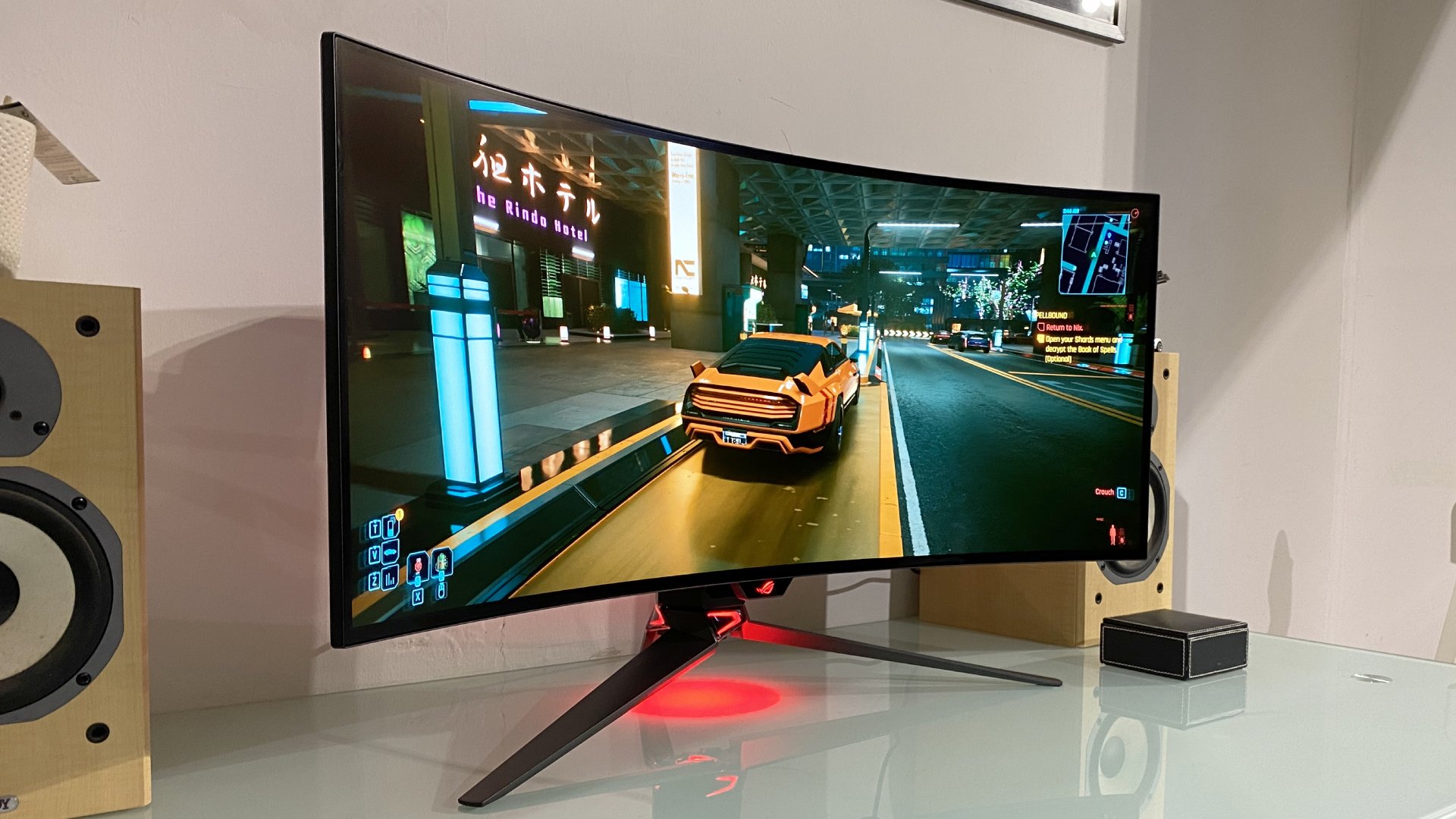


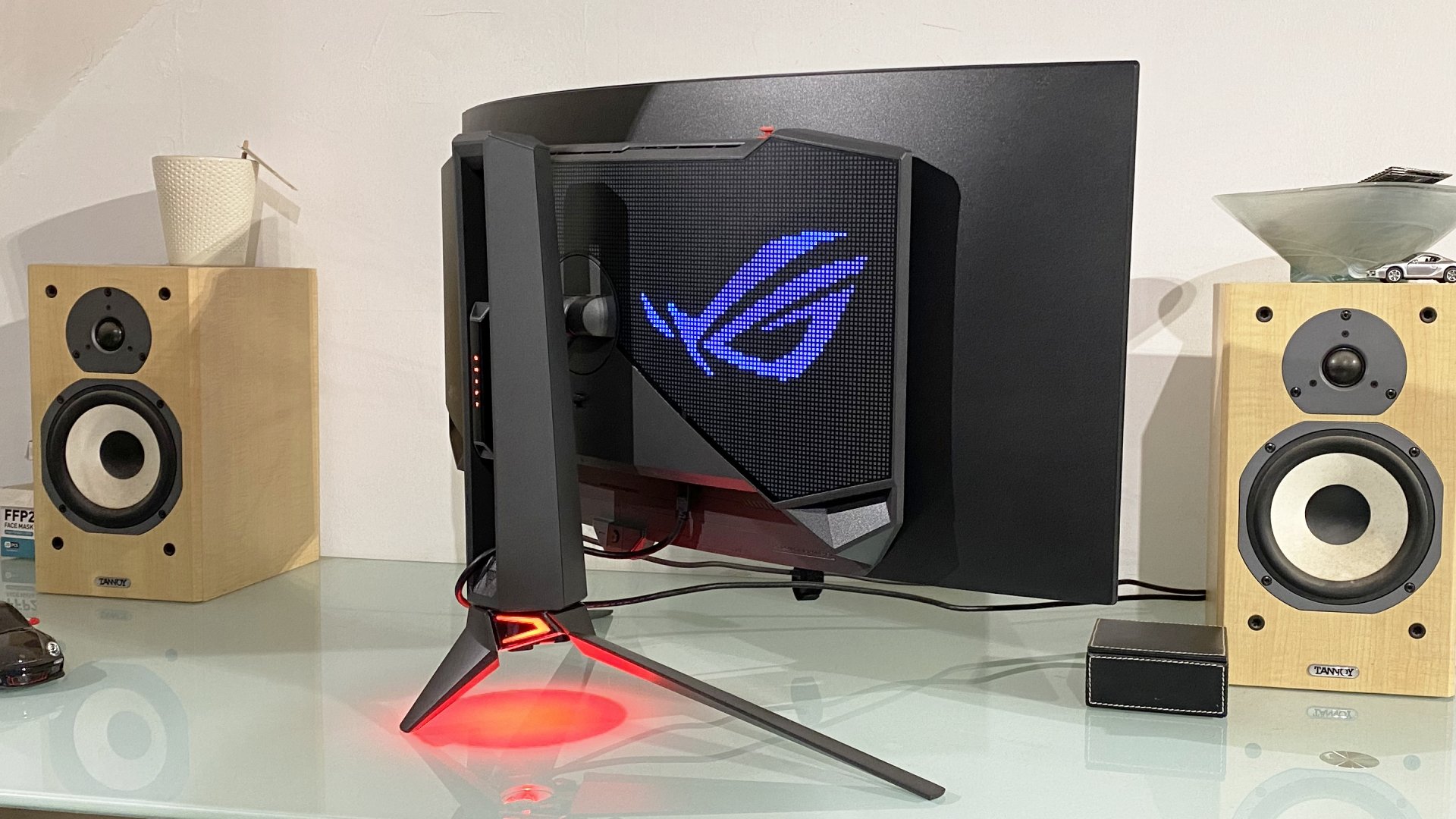
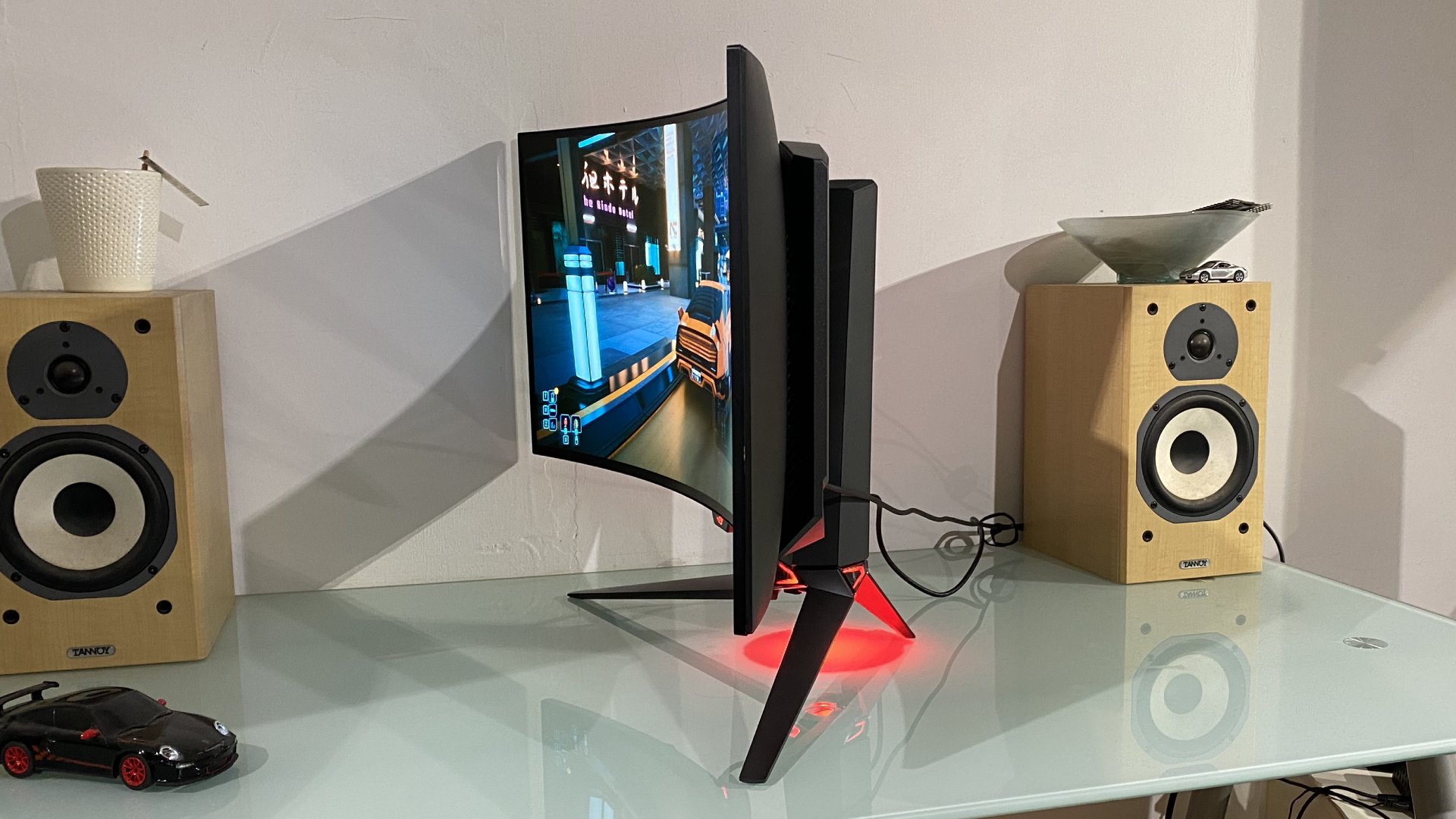
Specifications
Reasons to buy
Reasons to avoid
✅ You want the best visuals on offer right now: And that's a whole lot. While first-gen OLED panels are great, these more modern units really are top-notch. Add in a smooth curve and you have something truly amazing.
❌ You're not looking to spend a lot: It's dropped in price a fair bit since launch, but you'll still be paying north of $1,000 for this superb display.
The Asus ROG Swift OLED PG34WCDM is the best ultrawide curved gaming monitor primarily thanks to its gorgeous LG OLED panel. The pick for this spot on our list is hotly contested, but the PG34WCDM deserves the win here.
Its 3,440 x 1,440 resolution, 240 Hz refresh rate, and 99% DCI-P3 color coverage wouldn't be setting any new records for VA or IPS panels, but for an OLED panel, these specs are very impressive. But it's how the display looks in person that really makes it stand out.
We used the word "zing" in our review for this monitor, and that sums it up nicely. It handles HDR adeptly and has all the OLED loveliness you could hope for—super vibrant colors, perfectly deep blacks, and stunning general picture quality. Put simply, it's a jaw-droppingly good-looking display, and it's plenty fast at 240 Hz, too.
This monitor also works hard to keep the common complaints about OLEDs, such as text fringing, to a minimum. Its Clear Pixel Edge algorithm handles text better than most, and the display has several burn-in mitigation features. Just bear in mind, like all OED screens, burn-in won't be entirely eliminated. You'll certainly fare better with a screen that tries hard to minimise it, though, and the Asus is well-equipped in that regard.
The PG34WCDM has an MSRP of $1,299, which is a huge amount of money to pay for any monitor. But it's not quite so unusual for a good curved ultrawide, and when you throw the OLED panel into the mix, it makes sense. I've also seen it retailing closer to the $1,000 mark, which is a great price for something this gorgeous.
So yes, it's pricey, but it's also brilliant. If you're looking for the best ultrawide monitor right now, you're looking at the Asus ROG Swift OLED PG34WCDM.
Read our full Asus ROG Swift OLED PG34WCDM review.
The best budget ultrawide curved gaming monitor
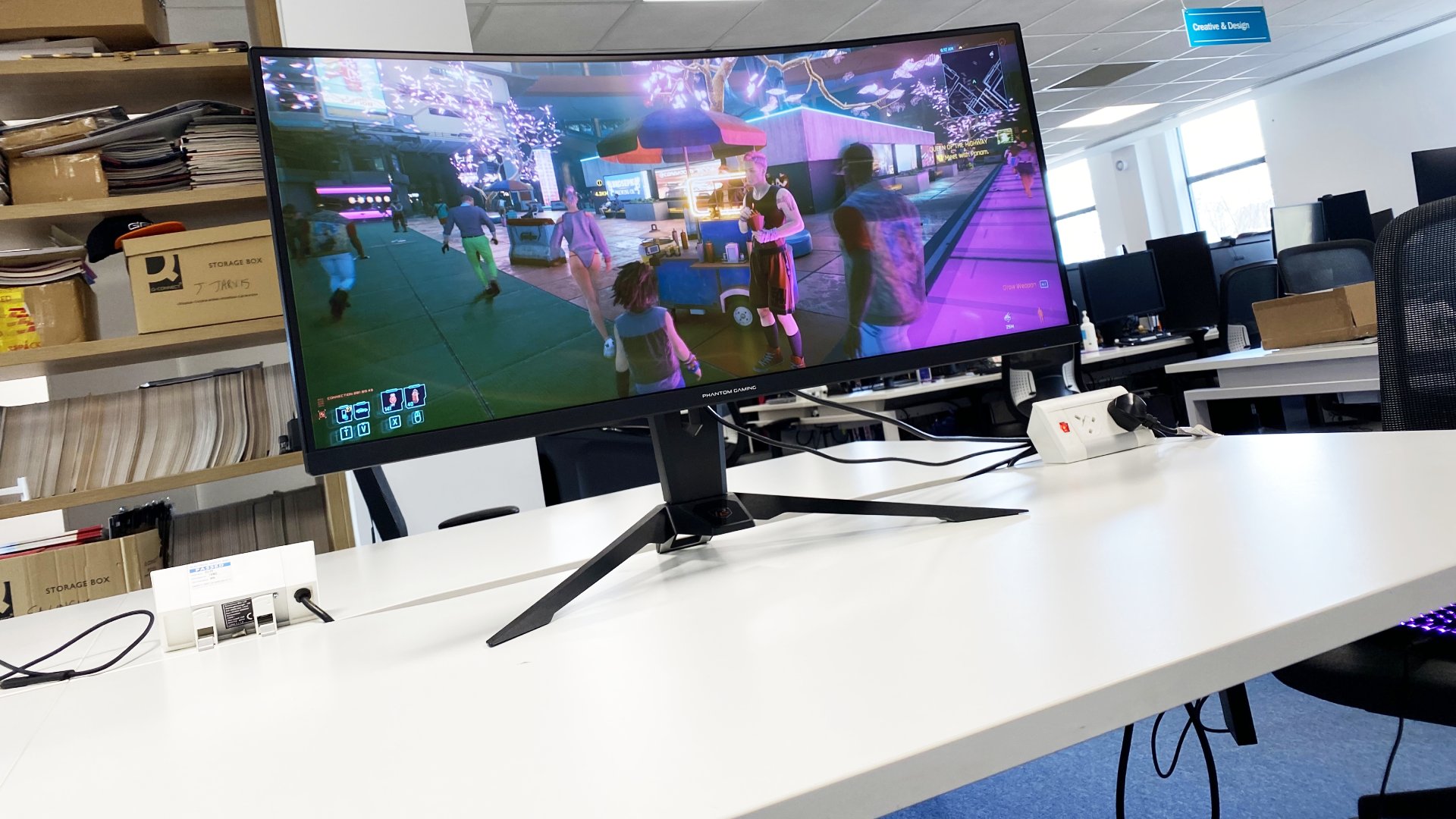
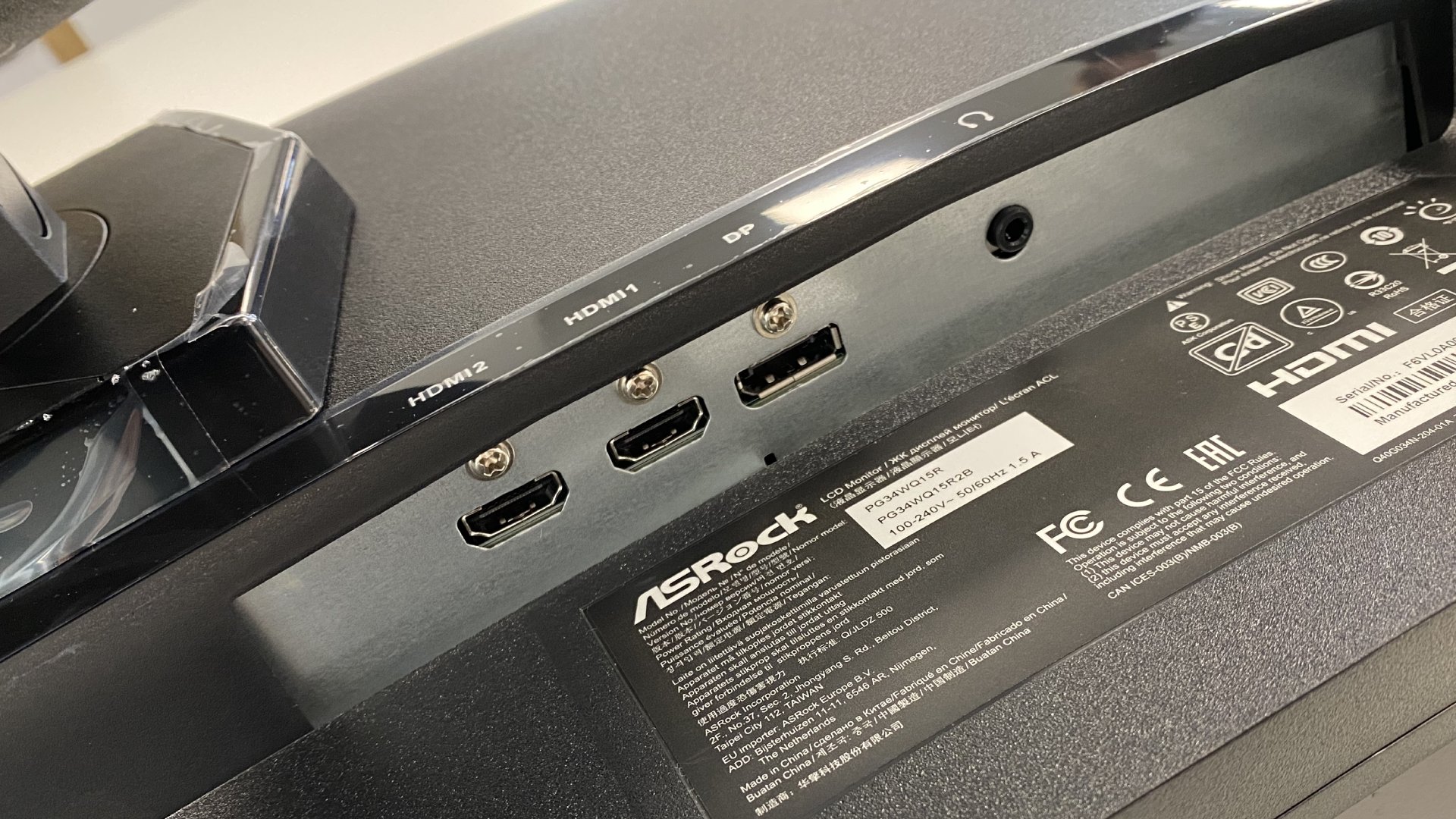




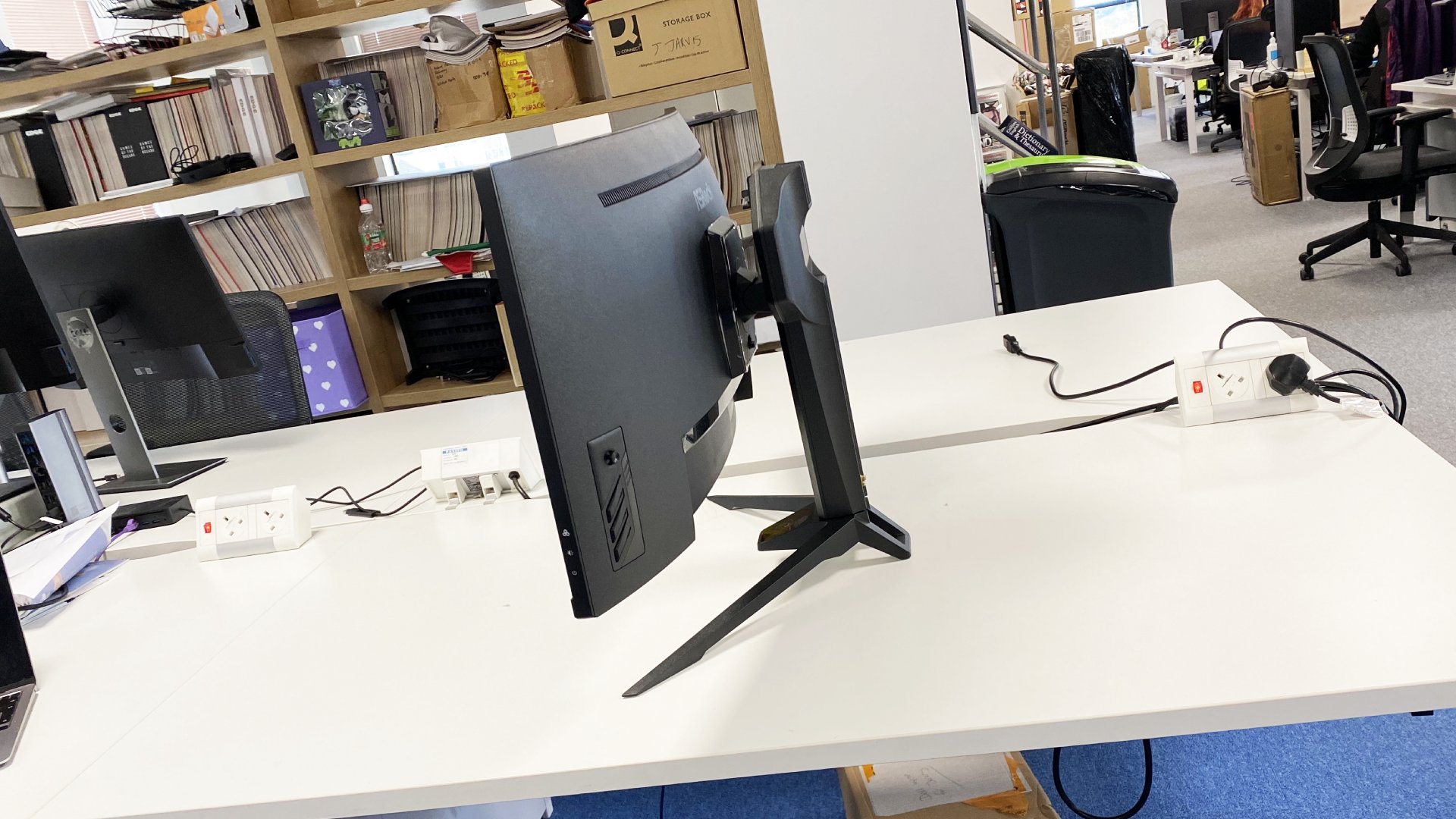
Specifications
Reasons to buy
Reasons to avoid
✅ You want ultrawide on a budget: Ultra widescreen gaming is super immersive, but can get very expensive to enjoy. That's not the case here.
❌ You want the best out-of-the-box experience: ASRock's monitor needs a fair bit of tweaking and calibration to run and look as good as it can, but that's to be expected at this price point.
The best budget ultrawide gaming monitor is the ASRock Phantom PG34WQ15R2B or PG34WQ15R3A. Yes, those are two different model names, but they're essentially the same monitor—the one we tested is the PG34WQ15R2B, but it might be easier to find the PG34WQ15R3A in stock. The only differences seem to be that the latter has a small screen on the monitor stand, "polychrome RGB", and ASRock low blue light tech.
The ASRock PG34WQ15R2B/3A's reasonable all-around specs show just how far monitors have come, when you can get a very decent ultrawide for an affordable price. This is ASRock's first gaming monitor, too, which is impressive. It's made an incredibly well-rounded display.
It has a 34-inch ultrawide VA panel capable of up to 165 Hz at 1440p. This refresh rate and resolution combo is, crucially, a solid mainstream gaming standard today, even for a non-ultrawide. That makes this monitor even more impressive, given it shoves in a bunch of extra pixels on the horizontal axis. It's also rated up to an impressive 550 nits peak brightness, and it claims a 1 ms MPRT response time.
So, really, probably the best way to think of this monitor is as an ultrawide version of the Pixio PXC277 Advanced above. You're getting a solid budget screen just like the PXC277, but with some extra horizontal real estate.
Combine this display's unusually high peak brightness with its 3,000:1 contrast and DisplayHDR 400 certification, and you have the makings of a decent HDR experience—nothing akin to true HDR, though, of course.
As with any VA monitor, it's certainly not the best pick for purely competitive gamers, given that this panel tech isn't quite as responsive as IPS tech. But its response times are respectable and, for your average gamer, the PG34WQ15R2B/3A is a cracking deal. It's certainly the best curved ultrawide I've spotted for this kind of price—and just to sweeten the deal, it regularly turns up on discount.
Read our full ASRock Phantom PG34WQ15R2B review.
The best 32:9 curved gaming monitor

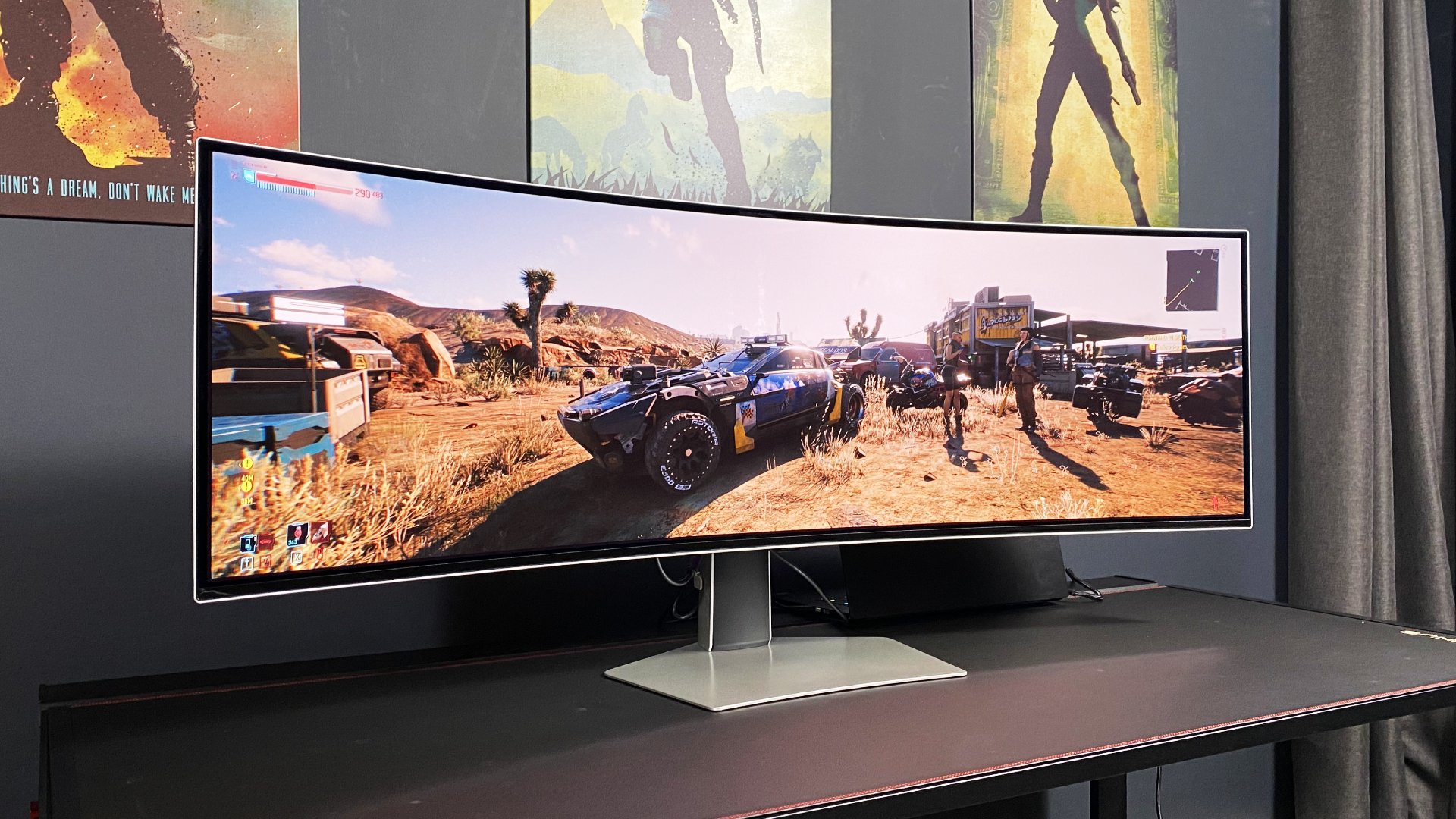


The OLED panel does look rather grey in extreme ambient lighting conditions.
(Image credit: Future)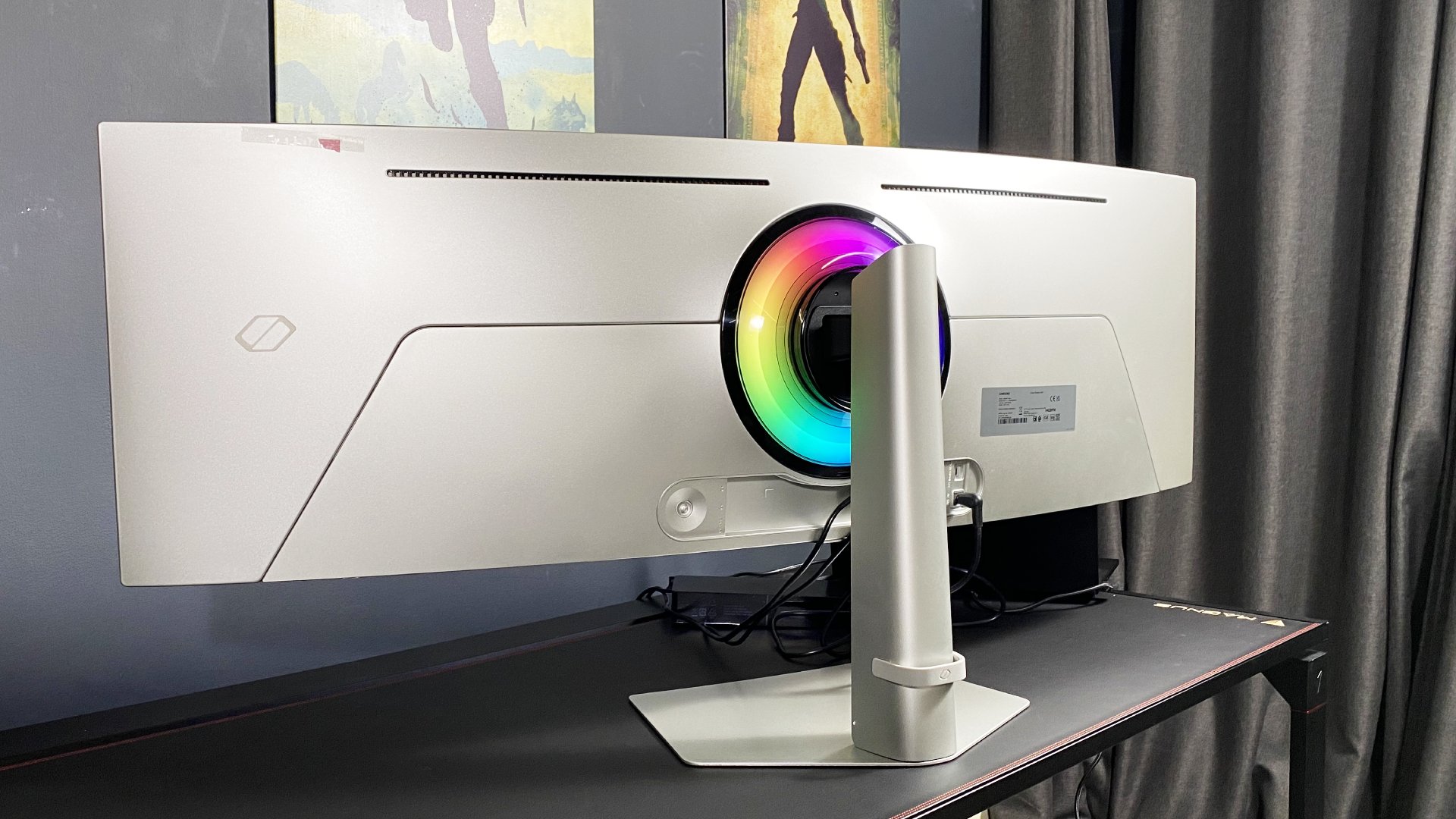
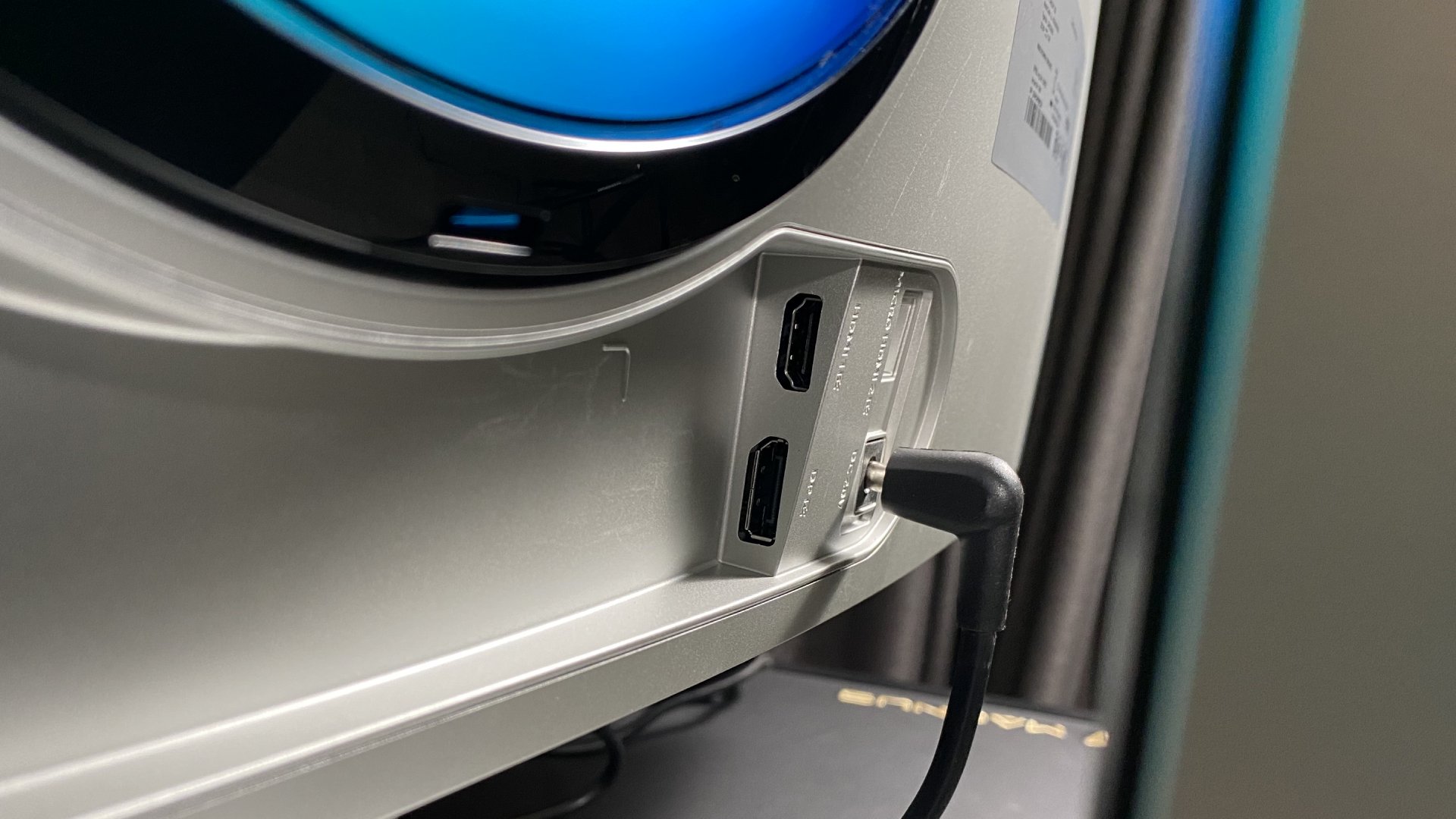
Specifications
Reasons to buy
Reasons to avoid
✅ You want full OLED immersion: If a regular serving of the best panel tech for gaming (OLED) isn't quite enough for you, this monitor gives you heaps more of it.
❌ You want to use this monitor for work: Although newer OLED panels with high pixel density don't suffer quite so much from text fringing, this one does, meaning it's not ideal for non-gaming desktop scenarios.
The best 32:9 curved gaming monitor is the Samsung Odyssey OLED G9, and yes, that is a real aspect ratio. Far from sticking with the already pretty wide 21:9 ratio of most ultrawide monitors, this one slaps a ton of extra pixels on either side to stretch out to a resolution of 5120 x 1440.
That ginormously wide aspect ratio plus an OLED panel makes for a mighty immersive gaming monitor. The 1800R curvature is pretty gentle for a monitor of this stature, though, at least compared to previous Samsung G9 panels with 1000R curvature.
You're getting the typical OLED affair here, too, which means you're getting stunning visuals: deep blacks, colours that pop, and of course, a very quick response time. Combine this with a 240 Hz refresh rate and you have something that not only makes games look great but also feel great to play, too. Provided, of course, that your GPU can keep up.
And I should probably point out that you shouldn't expect a monitor with such an abnormally wide aspect ratio to gel with every game. Not every game will support such widescreen resolutions, meaning you'll have to use black borders or deal with some… let's say, interesting peripheral stretching. In games where it does work, however, the result is unmatched, with a vibrant and immersive picture every way you look.
Admittedly, its pixel density isn't up there with the best, which can be a problem when not gaming (remember OLED panels with lower pixel density can cause text fringing and so on, thanks to their different subpixel layout). And it suffers, as OLEDs tend to, from a greying-out of blacks in bright ambient light.
But purely for gaming, the experience you're getting here is seriously stellar. The impressiveness of a 32:9, 49-inch OLED gaming experience just cannot be overstated.
Given that a monitor like this is sure to draw attention, Samsung has ensured it looks gorgeous in its own right, too. A minimalist stand and bezels give this a sleek, modern look that should suit most setups.
It might be a couple of years old now, but it's hard to match 49 inches of fast OLED at a 32:9 aspect ratio. If you're looking for something ultra-ultrawide and gorgeous for gaming, this is it.
Read our full Samsung Odyssey OLED G9 review.
Also tested
Gigabyte M034WQC2 OLED
Gigabyte's first OLED ultrawide is good in almost all categories, but a bit boring and a bit pricey for what it is. If you need a curved 240Hz QD OLED monitor, that's what you'll get here.
PC Gamer score: 80%
Read our full Gigabyte M034WQC2 review.
Acer Predator X39
The Acer X39 is a great monitor, though one that now feels rather expensive and outdated in light of CES 2025 announcements.
PC Gamer score: 80%
Read our full Acer Predator X39 review.
Acer Predator Z57
This cheaper take on the dual-4K 57-inch thing is just as impressive as Samsung's version. It also suffers from the same Mini-LED shortcomings. But then, there is no perfect display technology. For now...
PC Gamer score: 82%
Read our full Acer Predator Z57 review.
Samsung Odyssey Neo G9 G95NC
Samsung has copious form when it comes to pushing the boundaries of display technology. The Samsung Odyssey Neo G9 G95NC is true to that tradition. This dual-4K monster does things no other display can match. Admittedly, the mini-LED technology can't match OLED for lighting precision and panel response. And it costs a pile of money. But this is still the most spectacular gaming experience currently available.
PC Gamer score: 90%
Read our full Samsung Odyssey Neo G9 G95NC review.
Alienware 34 AW3423DWF
This Alienware monitor is a staple, offering glossy-coated 34-inch curved gaming goodness. But there are better options now, with better pixel density and at a cheaper cost.
Read our full Alienware 34 AW3423DWF review.
Asus ROG Swift OLED PG49WCD
It's massive, mighty, and one helluva OLED gaming monitor. Unfortunately for Asus, Samsung (the QD-OLED panel's manufacturer) offers more for less with the OLED G9.
Read our full Asus ROG Swift OLED PG49WCD review.
Samsung Odyssey OLED G9
Samsung previously raised the bar for gaming monitors with this one. But now, the Odyssey Neo G9 takes the crown and leaves this Odyssey in its wake.
Read our full Samsung Odyssey OLED G9 review.
Philips Evnia 34M2C8600
If Alienware's very similar 34-inch model was the OLED monitor we've been waiting for, Philips has just bested it. Thanks to a glossy panel coating, the OLED tech really sings. HDR games? They positively sizzle. A few minor OLED limitations remain. But this is as good as gaming monitors currently get.
Read our full Philips Evnia 34M2C8600 review.
Corsair Xeneon Flex OLED
Waiting for the big-screen monitor that really delivers on the promise of OLED tech? This isn't it. The Corsair Xeneon Flex 45WQHD240 suffers from all-too-apparent brightness limitations, while the resolution and pixel density are a very hard sell at this price point.
Read our full Corsair Xeneon Flex OLED review.
Xiaomi Mi Curved Gaming Monitor 34
This monitor failed to impress us compared to its competitors in its price bracket, but it's still one to check out if it's on sale. It's a budget monitor, so you don't get the latest and greatest panel, but it's a wide and curvy thing for relatively few pennies.
Read our full Xiaomi Mi Curved Gaming Monitor 34 review.
How we test curved gaming monitors
When we test curved gaming monitors, we live with them in the same way you would at home, using them not only for gaming but for day-to-day tasks on the Windows desktop, too.
This will highlight any failings in factory calibration and show any issues with font scaling. It is also a good way to test the vagaries of whatever backlighting tech a panel is employing. Using a dark background and a light browser or Explorer window (or the other way around) is great for highlighting what a screen's backlight will do as the level of brightness is demanded by what's on the display.
It's a good way to check out any auto brightness limiting (ABL) functions on a modern OLED display, too.
As far as gaming goes, fast-paced shooters are perfect for testing the response of a given gaming monitor, and the neon-dripping world of Cyberpunk 2077 makes for an excellent HDR tester. We try to cover a good range of use gaming use cases.
We also go through a series of experiential tests to highlight any ghosting, backlighting issues, or general smeariness or blurring of images. We find it too easy to get lost in the weeds of specific panel benchmarks and miss more obvious problems that might crop up during day-to-day gaming use.
So, we put more weight on what it's like to actually use a gaming monitor than what the specs might say. We also try to get more than one set of eyes on it when we can, because we know everyone's different and what looks good to one might look dull to another.
Best curved gaming monitor FAQ
What do I need to consider when buying a curved gaming monitor?
If you're considering ditching your flat-screen lifestyle for all-encompassing visuals, there are a few things to consider. First off, the three Rs: resolution, refresh rate, and response time.
Higher resolution means more load on your graphics card but more detailed images. A higher refresh rate means speedier visuals. And response time can be useful for bolstering your in-game reflexes.
The final consideration is curvature: See below.
What level of monitor curvature should I choose?
Your panel's curvature, or curve radius, is key to your viewing experience. Most curved panels are rated across a range: roughly 4000R to 1500R. The lower the number, the higher the curvature of the panel.
The distance you sit from your monitor will also help you choose which curvature is ideal for you. You'll generally find gaming monitors around the 1800R mark, right in the sweet spot for desktop gaming. A more pronounced curve, viewed at a greater distance, could negatively impact viewing angles and your overall experience.
Keep up to date with the most important stories and the best deals, as picked by the PC Gamer team.

Dave has been gaming since the days of Zaxxon and Lady Bug on the Colecovision, and code books for the Commodore Vic 20 (Death Race 2000!). He built his first gaming PC at the tender age of 16, and finally finished bug-fixing the Cyrix-based system around a year later. When he dropped it out of the window. He first started writing for Official PlayStation Magazine and Xbox World many decades ago, then moved onto PC Format full-time, then PC Gamer, TechRadar, and T3 among others. Now he's back, writing about the nightmarish graphics card market, CPUs with more cores than sense, gaming laptops hotter than the sun, and SSDs more capacious than a Cybertruck.
- Ben Mansill
- Jeremy LairdHardware writer

